全文HTML
--> --> -->在真空电子太赫兹器件的设计方法中, 用的最多的数值方法是基于第一性原理的粒子模拟(particle-in-cell, PIC)方法[11-16], 通过求解带电粒子运动的Newton-Lorentz力方程和电磁场Maxwell方程组, 实现对器件中电磁场与带电粒子非线性相互作用的模拟, 获得器件输出性能参数与器件结构参数和电子束参数之间的关系.
对于真空电子微波器件, 金属边界可以当做理想导体处理, 但对于毫米波尤其是太赫兹波, 电磁波对金属的趋肤厚度与器件的加工精度相当, 因此, 金属边界对太赫兹波的衰减较大, 从而大大影响了器件的工作特性[17].
在模拟带欧姆损耗的器件时, 等效电磁参数方法、有限电导率方法以及表面阻抗边界条件是3种常用方法. 等效电磁参数主要用于带有超材料结构器件的模拟; 有限电导率方法需要对导电介质内部进行网格剖分, 主要用于模拟包含低电导率材料的器件, 对于良导体这类电导率很大的介质, 电磁波在其中的波长非常短, 网格尺寸会非常小, 导致计算量急剧增加; 采用表面阻抗边界, 只需要根据良导体表面切向电场与表面附近磁场的关系, 在导体边界处网格内磁场推进时进行一定修正, 就能考虑导体表面的损耗效应, 并不需要求解导体内部的场. 目前的研究中, 表面阻抗边界条件主要用于半无限大空间有耗介质表面以及介质表面涂覆层的电磁场分布研究. 文献[18]中在研究瞬态电磁脉冲对有耗地面附近电缆耦合问题时, 采用表面阻抗边界作为地面的边界条件来模拟有耗地面的反射. 文献[19]中利用表面阻抗边界条件研究了涂覆等离子体薄层的金属材料的电磁散射特性. 文献[20]中采用表面阻抗边界作为石墨烯材料的边界, 研究这类器件的电磁特性. 由于电磁波损耗是频率的函数, 金属边界对太赫兹波的衰减是色散问题. 本文给出三维粒子模拟软件在采用共形边界情形下的频率色散表面损耗边界条件, 并对损耗算法进行验证. 将损耗边界的粒子模拟方法应用于两种典型的真空电子太赫兹源(圆柱结构相对论表面波振荡器和平板结构非相对论返波管)的模拟.
电场的计算采用时域有限差分方法[21]. 如图1所示, 电场和磁场交错布置在网格边和网格面上, 通过在时间和空间上将Maxwell方程进行离散化, 用差分代替微分, 最终实现电磁场的推进. 这种处理使得每一个网格单元都满足法拉第感应定律和安培环路定律, 很好保留了电磁场旋度与通量之间的关联特性.
 图 1 FDTD网格示意图
图 1 FDTD网格示意图Figure1. Schematic of FDTD cell.
带电粒子运动遵循Newton-Lorentz力方程
对(1)式和(2)式进行离散可得
随着真空器件工作频率的提高, 电磁场在器件金属壁面上的损耗也越来越大, 欧姆损耗的影响不能忽略. 尤其在太赫兹波段, 损耗对器件的起振时间、模式之间的竞争、输出效率及频带宽度都有很大影响[17]. 为了使模拟结果更加符合真实情况, 需要在程序代码中加入阻抗算法, 用于模拟有耗介质对器件工作性能的影响. 如果直接采用有限电导率模型, 需要在金属区域内部进行网格剖分并求解, 但是金属内电磁波的波长非常短, 为了满足网格步长Δ小于λ/10的条件, 网格尺寸会非常小, 导致计算量急剧增加. 如果采用表面阻抗边界[22], 只需要根据良导体表面切向电场与表面附近磁场的关系, 在磁场推进时加入导体表面上电场的作用, 就能考虑导体表面的损耗效应, 并不需要求解导体内部的场.
目前的粒子模拟软件多采用阶梯近似的方法来逼近模型边界, 采用阶梯近似网格在粒子模拟中会出现两个问题[23]: 不能准确求解弯曲边界处的电磁场; 不能准确描述弯曲的阴极面上的粒子发射. 粒子模拟软件UNIPIC-3D基于射线与几何体的求交算法, 实现了三维复杂模型的共形网格生成技术[23], 在共形网格上应用Maxwell方程组的离散积分方法对电磁场进行推进. 有些共形网格的面积可能会很小, 由稳定性条件可知过小面元会使时间步长缩短, 为了克服这个问题, UNIPIC-3D中采用Simple-Conformal共形算法[23-26]. 以图2所示局部共形网格为例, 对磁场进行推进时需要计算局部真空面元上电场的环路积分:
 图 2 局部共形网格
图 2 局部共形网格Figure2. Local conformal grid.
考虑导体的高频损耗, 其核心问题是将理想导体的边界条件, 改为非理想导体的边界条件, 即其表面的切向电场分量不为零, 而是与附近的切向磁场满足如下形式的阻抗关系[27]
(7)式给出了频域形式的阻抗关系, 为了将阻抗边界用于时域共形电磁场求解, 需要推导时域阻抗关系. 以z平面内x方向电场分量为例, 对(7)式进行逆傅里叶变换:
图3为模拟所得腔内偏离激励源一定位置的观测点处y方向电场随时间变化曲线, 可以看出: 1)该电压脉冲激励起腔内的谐振, 通过对时域波形进行FFT变换, 所得频率为6.51 GHz, 与理论值相符; 2)由于腔体表面的损耗, 起振后腔内电场振荡的幅度逐渐减弱. 如图3中蓝色曲线所示, 对电场幅值(上包络线)进行负指数拟合得到的指数项系数为–6.24 × 107. 谐振腔Q值与角频率ω和衰减常数α的关系为Q = ω/2α, 由此可计算出谐振腔的Q值为325, 与理论值相符合较好, 验证了欧姆损耗算法的正确性.
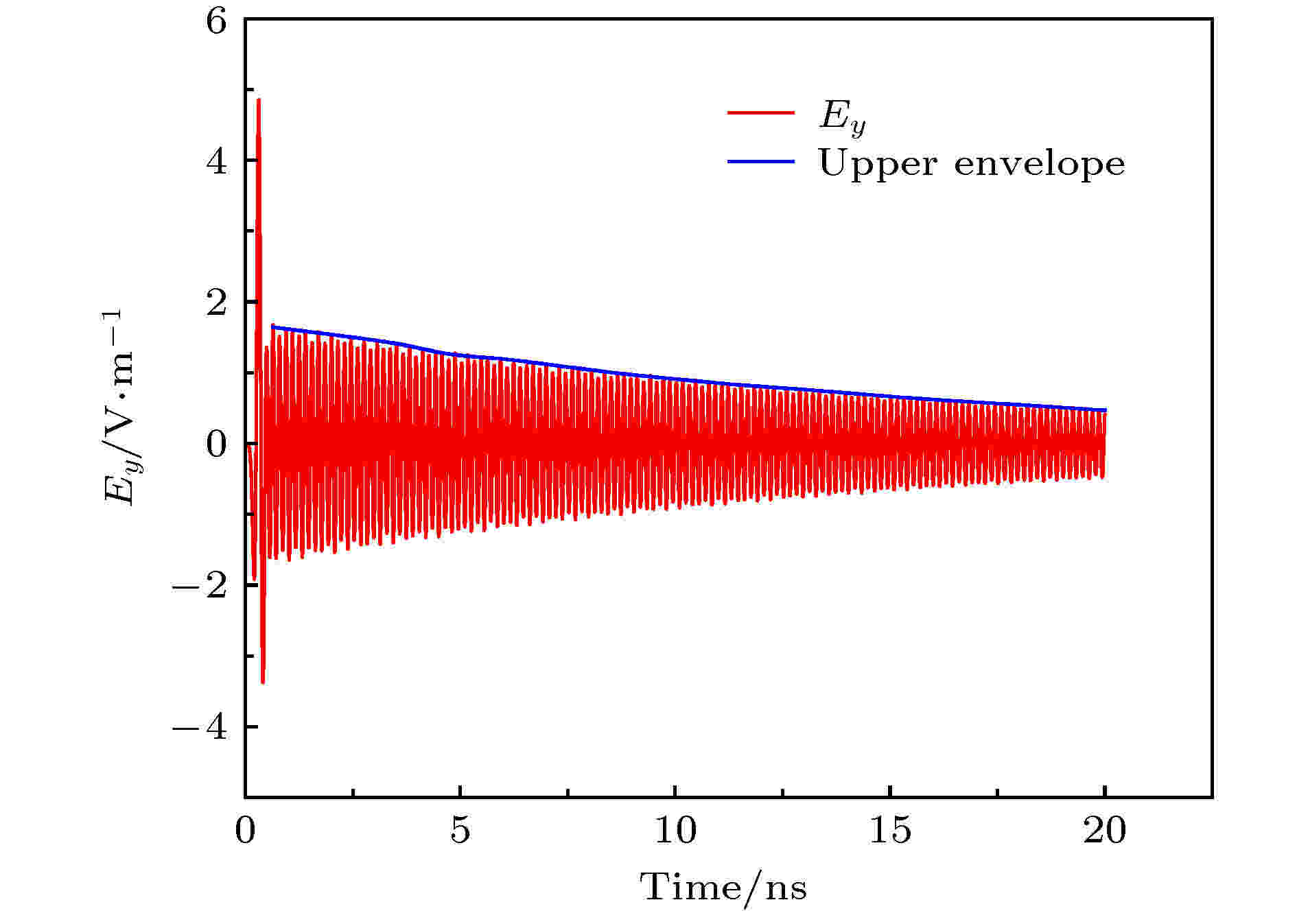 图 3 谐振腔内诊断点处电场时间波形
图 3 谐振腔内诊断点处电场时间波形Figure3. Time history of electric field inside a resonator.
另外, 采用新的损耗算法模拟了圆柱波导中电磁场的传播, 波导半径a = 0.5 mm, 长度为25 cm, 内壁电导率σ = 5.8 × 107 S/m. 可以计算出波导壁面的电阻为
| 距离/cm | 理论值/P0 | 模拟值/P0 | 相对误差/% |
| 5 | 0.8964 | 0.8933 | 0.3 |
| 10 | 0.8035 | 0.7969 | 0.8 |
| 15 | 0.7203 | 0.7105 | 1.4 |
| 20 | 0.6457 | 0.6335 | 1.9 |
表1圆波导中模拟Poynting通量与理论解的对比
Table1.Comparison of simulated and analytic Poynting flux in a circular waveguide.
2
4.1.相对论表面波振荡器的模拟
太赫兹表面波振荡器是一种圆周对称契轮科夫器件, 通过采用慢波结构将器件中电磁波的相速度降到接近电子的群速度并与电子发生束波互作用而产生太赫兹波, 具有结构紧凑、功率高、适合重复频率工作等优点[6]. Wang等[6]研制了相对论太赫兹表面波振荡器, 包含无箔二极管、环形阴极、慢波结构、输出结构和外加引导磁场. 除了图中的准直段的反射腔外, 其结构如图4所示, 采用矩形慢波结构, 慢波段内半径为3 mm, p = 0.32 mm, h = 0.1 mm, d = 0.18 mm, 周期数为30. 380 kV的高电压波从左端口注入, 当阴极表面电场达到发射阈值后, 电子会自洽的向外发射, 发射电流约为2.2 kA, 引导磁场幅值为5.25 T. 在无耗和有耗边界条件下, PIC模拟得到的器件输出功率分别为91 MW和41 MW, 工作频率为0.377 THz, 电磁波模式为TM01模[30].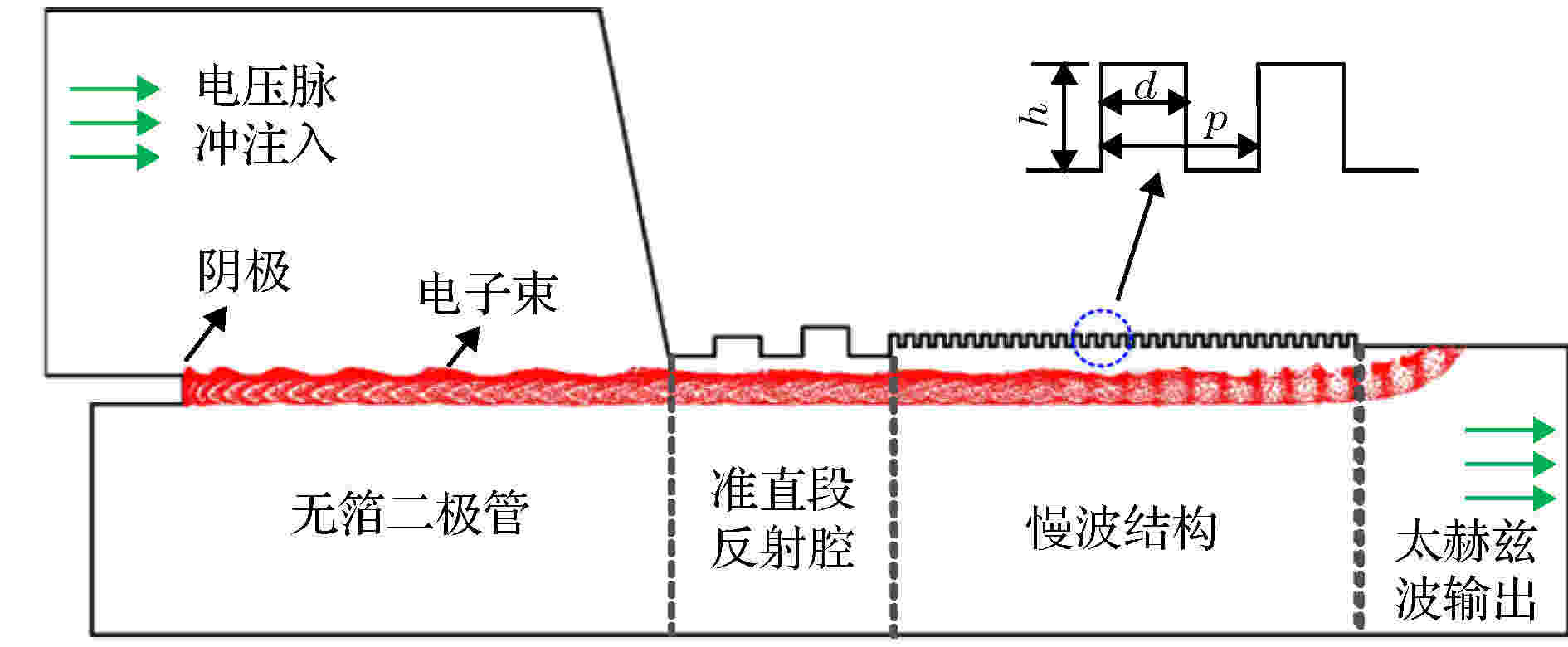 图 4 表面波振荡器示意图
图 4 表面波振荡器示意图Figure4. Schematic of a surface wave oscillator.
为了提高返波管高功率微波的产生效率, 在电子枪和慢波结构之间加入反射腔[31-35], 如图4所示. 反射腔可以对电子束进行预调制, 并对器件中的返波进行反射, 增强慢波结构中电磁波的强度, 从而提高波束互作用效率. 本文采用加入损耗边界的UNIPIC-3D软件模拟了如图4所示的带反射腔的太赫兹表面波振荡器的工作过程. 波导输出端采用CPML吸收边界进行截断[29]. 模拟中对器件壁面分别采用理想导体边界和非理想导体边界, 有耗边界采用铜的电导率σ = 5.8 × 107 S/m.
图5是模拟得到SWO稳定起振后某时刻轴向电场云图, 可以看出器件中的波沿着慢波结构表面传输, 电场最强的地方集中在慢波结构附近, 这也是表面波振荡器工作的特点, 因而这类器件的欧姆损耗会更加明显. 从电场空间分布来看, 经过约两个慢波结构后电场的相位发生一次变化, 即器件工作在π模附近[30]. 模拟得到的粒子空间分布如图4所示, 可以看出由阴极发射的电子注在管内同谐波发生互作用, 受到良好的密度调制, 群聚效果明显.
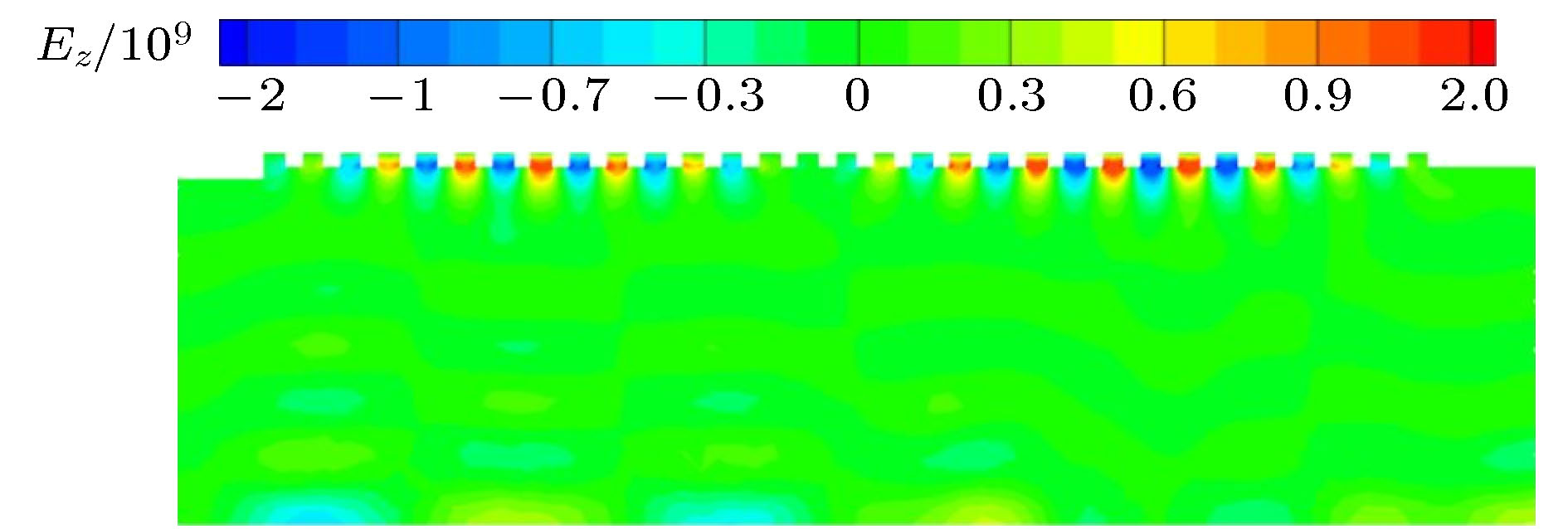 图 5 SWO内z方向电场分布云图
图 5 SWO内z方向电场分布云图Figure5. Contour of the Ez inside the SWO.
图6和图7分别为采用理想导体边界和有耗边界时靠近慢波结构的观测点处径向电场的时间变化曲线, 对其进行傅里叶变换可以看出器件的工作频率为0.337 THz, 电场的频谱纯度很高, 没有其他高次模出现, 表明在加入反射腔后器件的工作频率没有发生变化. 另外从图7可以看出加入表面损耗后, 电场时间变化曲线的包络曲线波动变大, 可能是因为考虑表面损耗后器件内能量分布发生了变化, 影响了器件的起振过程和后续的稳定输出.
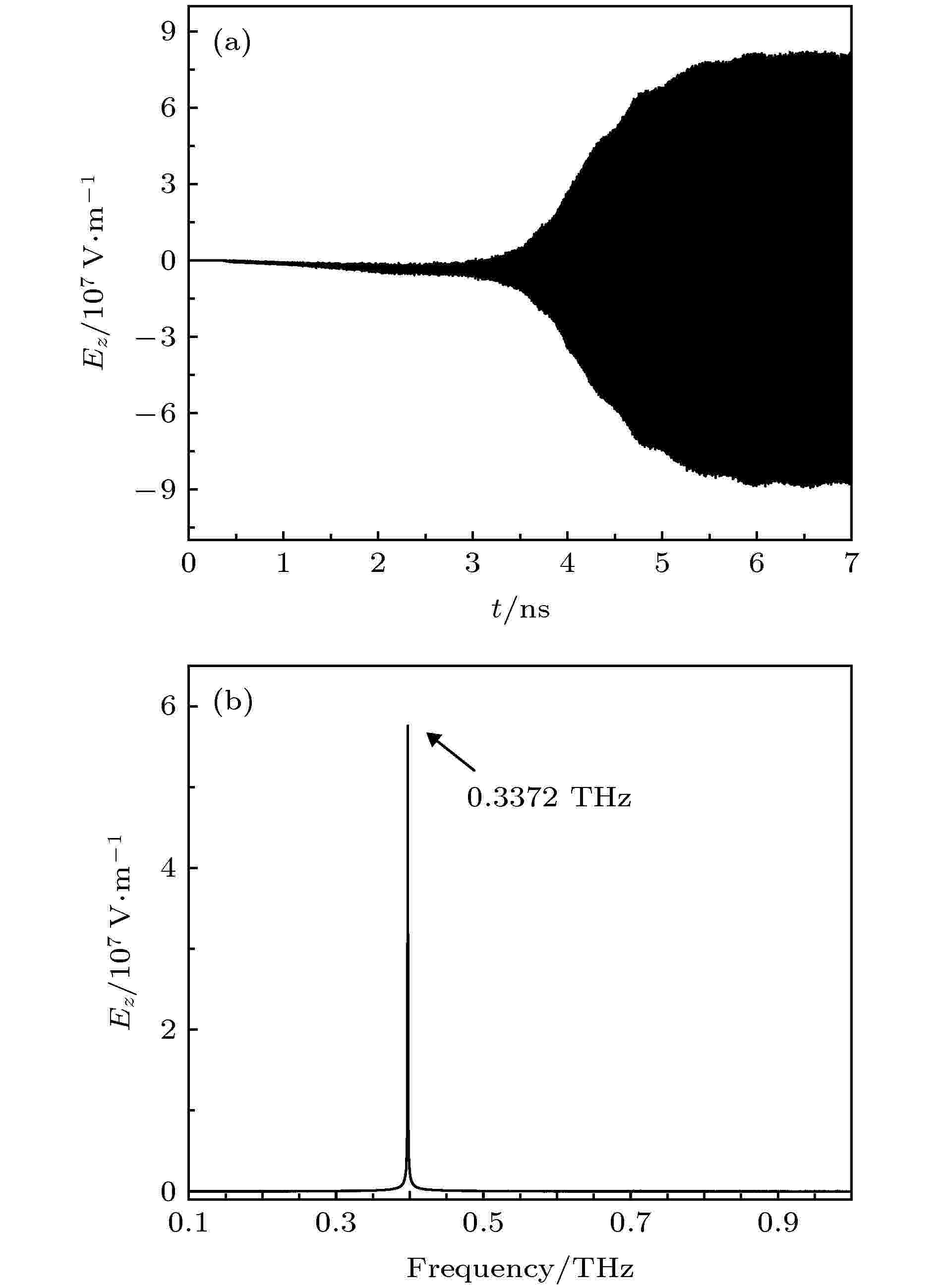 图 6 理想导体SWO中 (a)电场时间波形; 电场频谱(b)
图 6 理想导体SWO中 (a)电场时间波形; 电场频谱(b)Figure6. Time history of the electric field (a) inside the SWO with PEC and its spectrum (b).
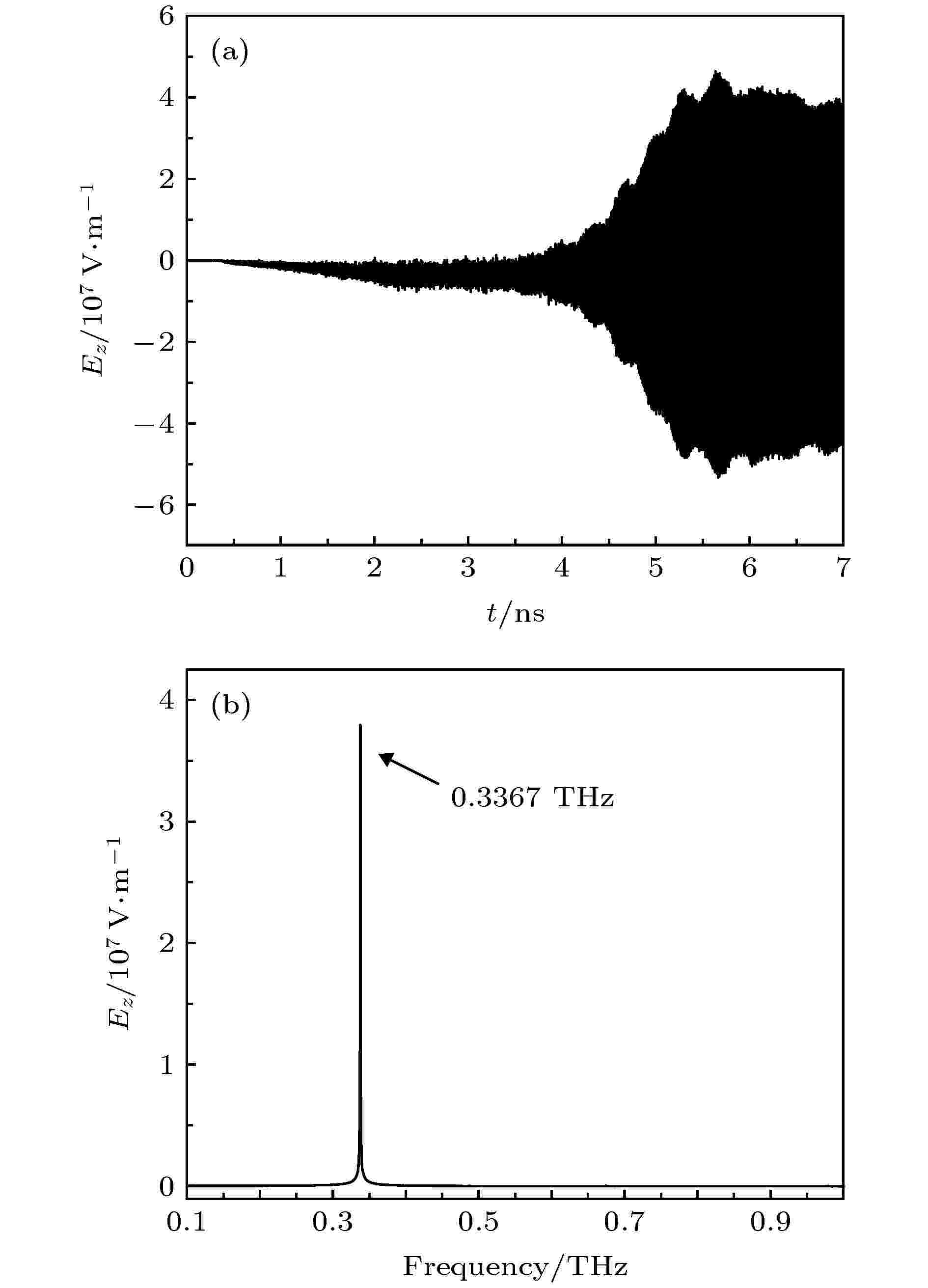 图 7 有损耗铜材料SWO中 (a)电场时间波形; (b)电场频谱
图 7 有损耗铜材料SWO中 (a)电场时间波形; (b)电场频谱Figure7. Time history of the electric field (a) inside the SWO with lossy copper and its spectrum (b).
图8为分别采用两种材料所得输出功率, 对比可以看出采用真实的金属材料边界后, SWO的输出功率下降非常明显, 这也解释了之前模拟得到的功率远大于实验测量功率的现象[6]. 另外可以看出采用有耗边界以后, 该器件的起振时间发生了延迟. 为了加快器件的起振, 可以采用外加太赫兹源牵引器件快速起振[36].
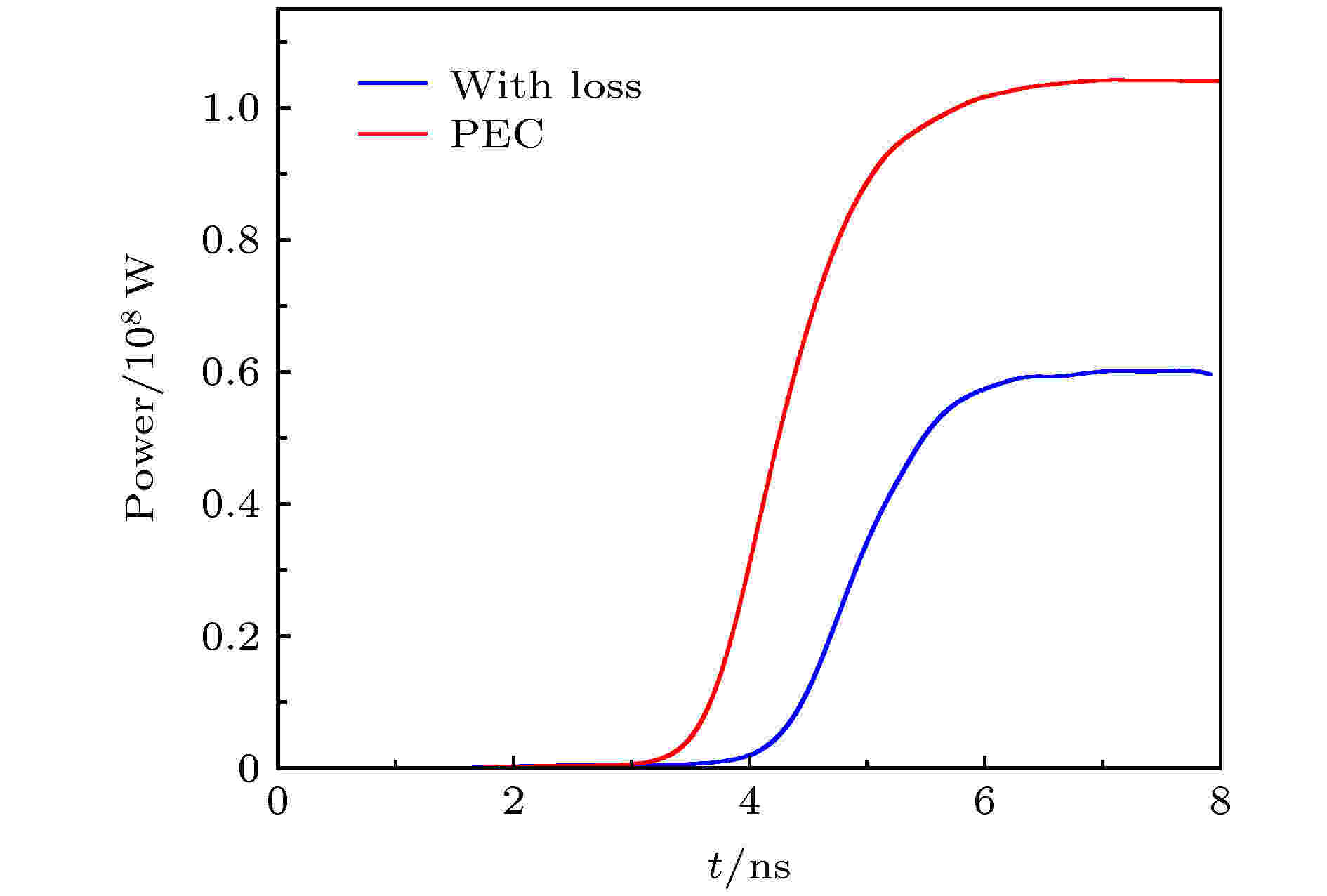 图 8 SWO输出功率
图 8 SWO输出功率Figure8. Output power from the SWO.
对比无反射腔的表面波振荡器[6], 带反射腔的表面波振荡器的工作频率没有变化, 但输出功率有非常明显的增加, 在PEC情形下, 输出功率由91 MW增加到105 MW, 在考虑损耗边界条件下, 输出功率由41 MW增加到约60 MW.
2
4.2.带状电子注平板返波管模拟
Xi等[10]研制了低电压带状电子注平板返波管, 如图9所示, 主要由电子枪、慢波结构、收集极和外围波导及输出波导组成. 不同于上面的大功率SWO, 该平板返波管采用5 kV的低电压热阴极电子枪, 发射电流为200 mA. 采用带状电子注能减弱空间电荷力导致的束流扩散, 而平板格栅慢波结构则易于加工[10]. 互作用段采用平板格栅慢波结构, 具体的几何参数如图中参数所示. 阴极发射面的尺寸为2.5 mm × 0.14 mm, 沿z方向加载了强度为0.9 T的引导磁场. 电子注沿+z方向传播并与慢波结构中的电磁波发生互作用. 产生的太赫兹波沿–z方向传播, 最终沿左下方输出波导输出. 图 9 平板BWO结构示意图(外围波导尺寸: 宽a = 7.2 mm, 高b = 1.8 mm; 格栅尺寸: 周期l = 0.1 mm, 宽w = 2.5 mm, 高h = 0.16 mm, 间距d = 0.058 mm; 格栅周期数140)
图 9 平板BWO结构示意图(外围波导尺寸: 宽a = 7.2 mm, 高b = 1.8 mm; 格栅尺寸: 周期l = 0.1 mm, 宽w = 2.5 mm, 高h = 0.16 mm, 间距d = 0.058 mm; 格栅周期数140)Figure9. BWO with planar structure.(a = 7.2 mm, b = 1.8 mm; l = 0.1 mm, w = 2.5 mm, h = 0.16 mm, d = 0.058 mm)
图10给出了起振后宏粒子z方向速度随纵向坐标的分布, 可以看出电子的速度以0.136倍光速为基准上下波动, 随着电子向前运动, 电子逐渐受到速度调制和密度调制而出现群聚, 电子的能量也逐渐降低, 表征着电子能量逐渐向太赫兹波能量发生转化.
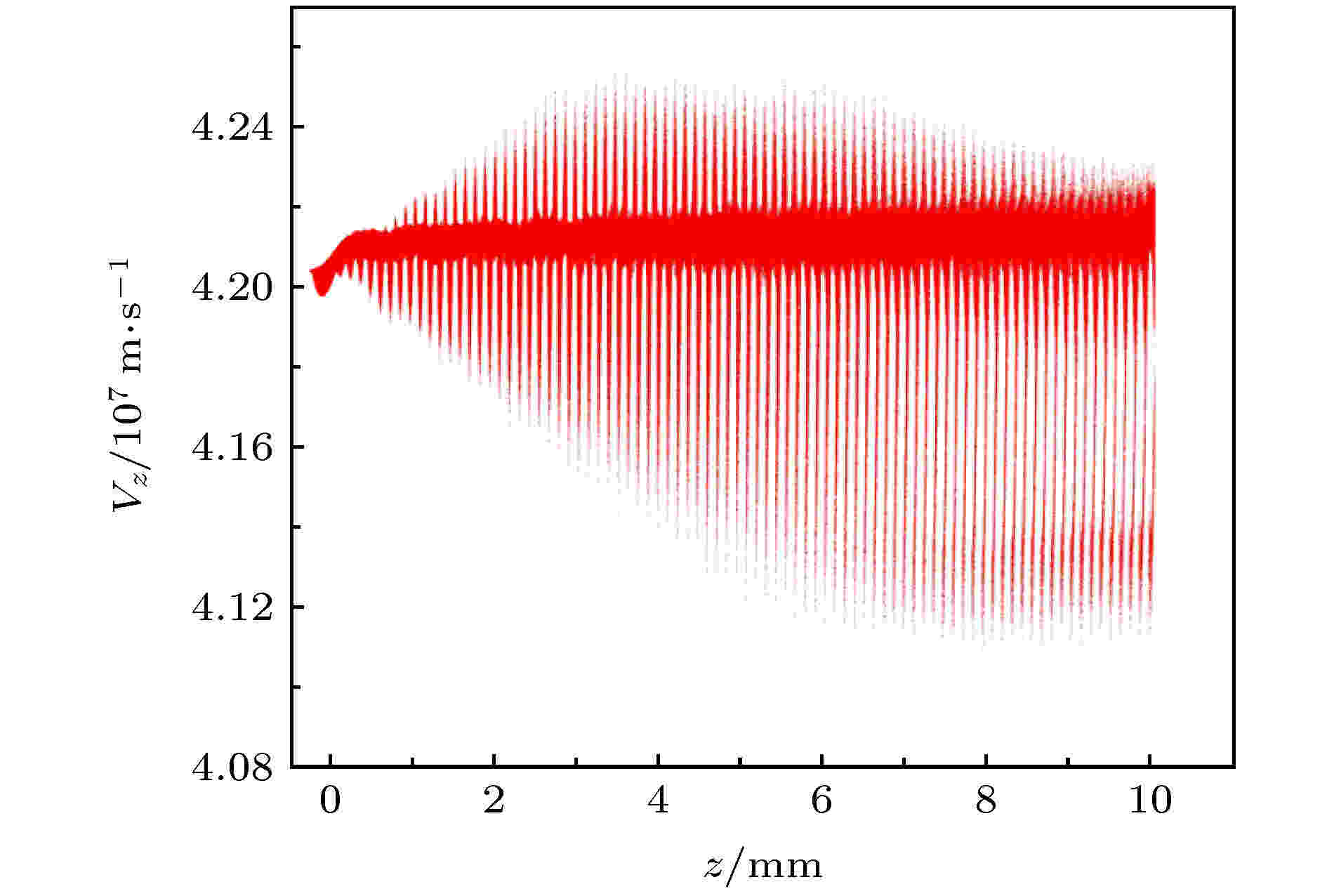 图 10 BWO中电子相空间图
图 10 BWO中电子相空间图Figure10. Phase space of electrons in the BWO
图11(a)为采用理想导体边界时输出波导内诊断到的z方向电场时间波形. 图11(b)为考虑表面损耗时模拟得到相同位置处的结果, 选择铜材料. 可以看出, 输出电磁波的频率为0.34 THz, 没有其他模式. 采用理想导体边界所得监测点处电场的峰值约为采用有耗边界时的1.6倍, 欧姆损耗对器件中电场的幅值影响非常大.
 图 11 BWO中电场波形 (a)无损耗; (b)有损耗
图 11 BWO中电场波形 (a)无损耗; (b)有损耗Figure11. Time history of electric field in the BWO with PEC (a) and lossy copper (b).
图12为输出波导段监测到的输出功率时间曲线, 采用理想导体边界时模拟到的输出功率约为1.8 W, 而采用有耗金属边界得到的输出功率约为0.65 W, 两者比值正好近似于前面电场峰值比值的平方. 另外, 对该器件实验测量到的输出功率约为0.18 W[10], 可见采用损耗边界模拟到的结果更接近实测值, 至于模拟解与实测值出现的差距可能是因为太赫兹器件结构过于微细, 阴极电子枪的品质、器件加工及装配误差等都会对器件的工作状态带来很大影响. 另外, 考虑到这类器件加工时的粗糙度, 实际器件中的表面损耗也会更大. 从功率曲线还可以看出采用有耗边界后该BWO器件的起振时间也发生了延迟.
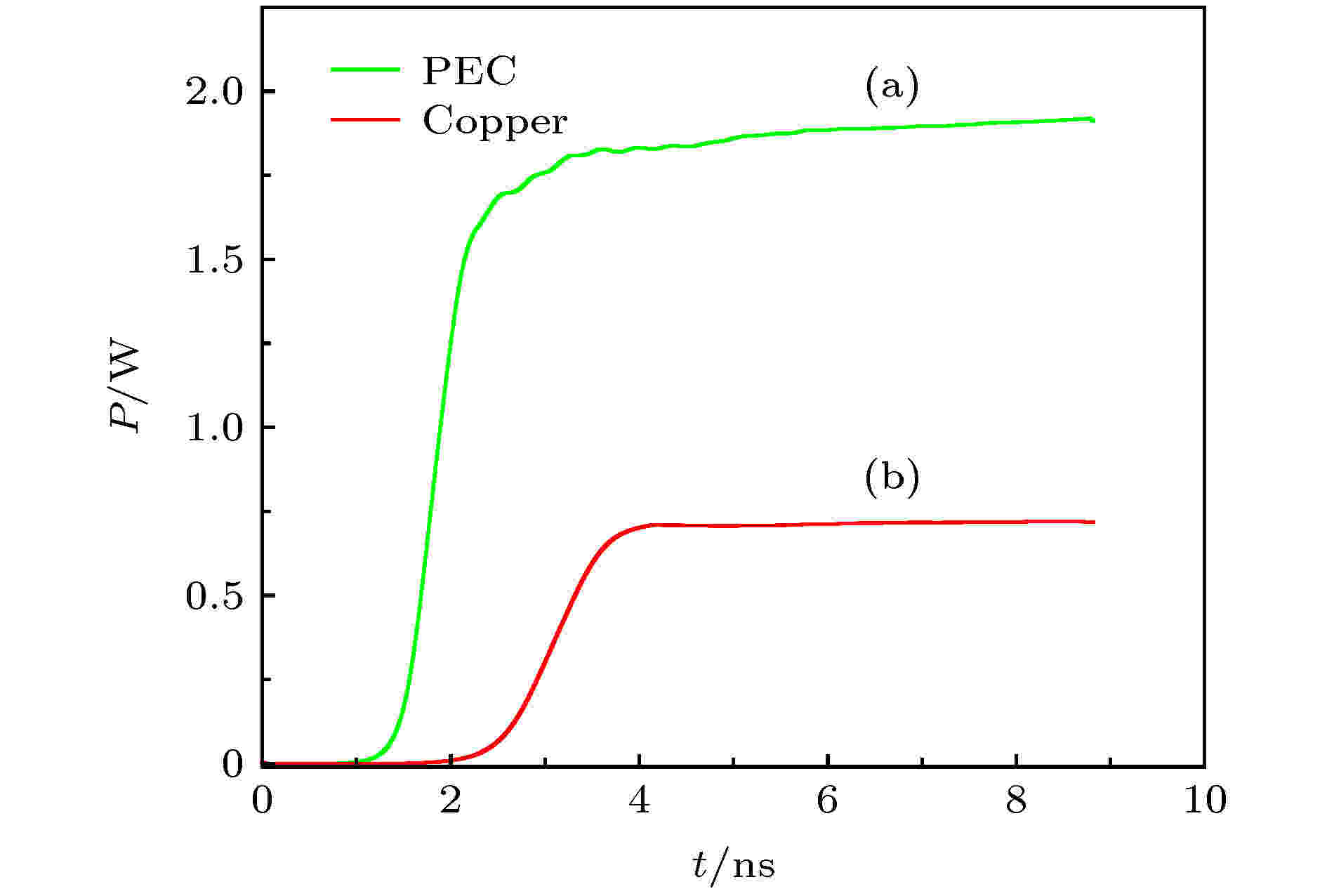 图 12 BWO输出功率 (a) PEC边界的结果; (b)有耗金属边界的结果
图 12 BWO输出功率 (a) PEC边界的结果; (b)有耗金属边界的结果Figure12. Output power from the BWO: (a) PEC ; (b) lossy copper.
